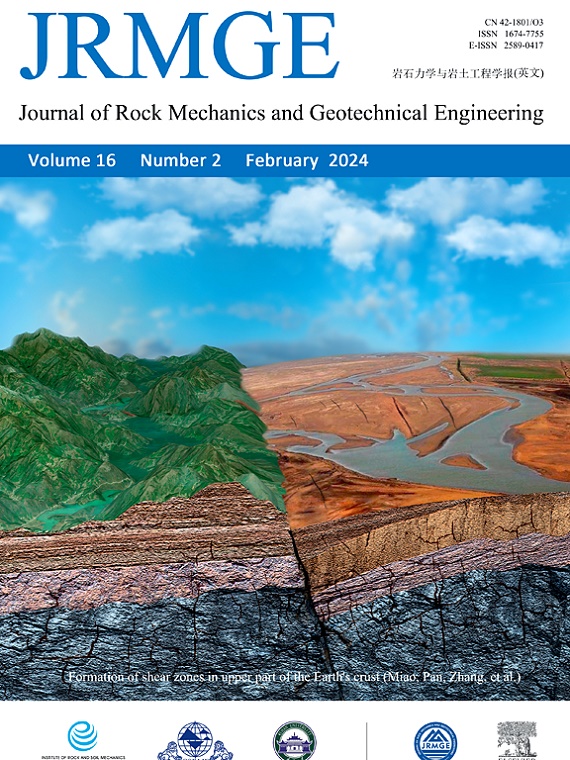Dynamic mechanical characteristics of deep Jinping marble in complex stress environments
IF 10.2
1区 工程技术
Q1 ENGINEERING, GEOLOGICAL
Journal of Rock Mechanics and Geotechnical Engineering
Pub Date : 2023-10-01
DOI:10.1016/j.jrmge.2023.08.005
引用次数: 0
Abstract
To reveal the dynamic mechanical characteristics of deep rocks, a series of impact tests under triaxial static stress states corresponding to depths of 300–2400 m were conducted. The results showed that both the strain rates and the stress environments in depth significantly affect the mechanical characteristics of rocks. The sensitivity of strain rate to the dynamic strength and deformation modulus shows a negative correlation with depth, indicating that producing penetrative cracks in deep environments is more difficult when damage occurs. The dynamic strength shows a tendency to decrease and then increase slightly, but decreases sharply finally. Transmissivity demonstrates a similar trend as that of strength, whereas reflectivity indicates the opposite trend. Furthermore, two critical depths with high dynamically induced hazard possibilities based on the China Jinping Underground Laboratory (CJPL) were proposed for deep engineering. The first critical depth is 600–900 m, beyond which the sensitivity of rock dynamic characteristics to the strain rate and restraint of circumferential stress decrease, causing instability of surrounding rocks under axial stress condition. The second one lies at 1500–1800 m, where the wave impedance and dynamic strength of deep surrounding rocks drop sharply, and the dissipation energy presents a negative value. It suggests that the dynamic instability of deep surrounding rocks can be divided into dynamic load dominant and dynamic load induced types, depending on the second critical depth.为揭示深部岩石的动态力学特性,开展了相应深度300 ~ 2400 m的三轴静应力状态下的一系列冲击试验。结果表明,应变速率和深部应力环境对岩石力学特性有显著影响。应变率对动强度和变形模量的敏感性与深度呈负相关关系,表明深部环境中发生损伤时更难以产生穿透性裂纹。动强度呈先减小后小幅增大的趋势,最后急剧减小。透射率的变化趋势与强度的变化趋势相似,反射率的变化趋势则相反。第一个临界深度为600 ~ 900 m,超过该深度,岩石动力特性对应变速率的敏感性和周向应力约束降低,导致围岩在轴向应力条件下失稳。在1500 ~ 1800 m处,深部围岩波阻抗和动强度急剧下降,耗散能呈负值。根据第二临界深度的不同,深部围岩动力失稳可分为动荷载主导型和动荷载诱导型。
本文章由计算机程序翻译,如有差异,请以英文原文为准。
求助全文
约1分钟内获得全文
求助全文
来源期刊

Journal of Rock Mechanics and Geotechnical Engineering
Earth and Planetary Sciences-Geotechnical Engineering and Engineering Geology
CiteScore
11.60
自引率
6.80%
发文量
227
审稿时长
48 days
期刊介绍:
The Journal of Rock Mechanics and Geotechnical Engineering (JRMGE), overseen by the Institute of Rock and Soil Mechanics, Chinese Academy of Sciences, is dedicated to the latest advancements in rock mechanics and geotechnical engineering. It serves as a platform for global scholars to stay updated on developments in various related fields including soil mechanics, foundation engineering, civil engineering, mining engineering, hydraulic engineering, petroleum engineering, and engineering geology. With a focus on fostering international academic exchange, JRMGE acts as a conduit between theoretical advancements and practical applications. Topics covered include new theories, technologies, methods, experiences, in-situ and laboratory tests, developments, case studies, and timely reviews within the realm of rock mechanics and geotechnical engineering.
 求助内容:
求助内容: 应助结果提醒方式:
应助结果提醒方式:


